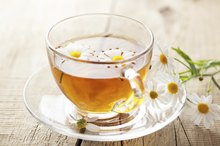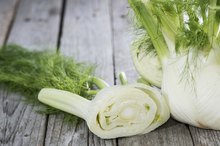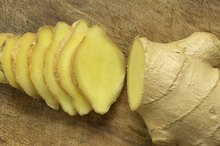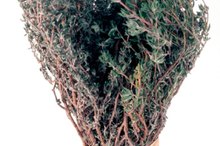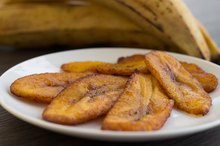Can I Eat the Russian Sage Growing in My Garden?
Botanical historians speculate that the confusingly named Russian sage became entangled with culinary sage because of its pungent scent. Although both are far-flung members of the mint family, culinary sage, or Salvia, claims no real kinship to Russian sage, or Perovskia atriplicifolia 1. Even more confusingly, the Asian native does not hail from Russia, but was brought to Western attention by a Russian general. Because of the “sage” in its nickname, some gardeners wonder if its foliage can be used like that of the culinary sages.
Description
Resembling a small shrub, Russian sage works well as a foundation plant or in the back row of a flowering border. The tall perennial bears multiple purple-flowering spikes and silvery-gray foliage. It begins to flower in late summer. The 3- to 5-foot-tall plant tolerates drought and chalky soils, but it can be included in gardens that require regular watering, notes the Colorado State University Extension service. Do not plant it in boggy soil. The hardy plant thrives in zones 3 to 9, or all but the most arctic or tropical climates.
- Resembling a small shrub, Russian sage works well as a foundation plant or in the back row of a flowering border.
- The 3- to 5-foot-tall plant tolerates drought and chalky soils, but it can be included in gardens that require regular watering, notes the Colorado State University Extension service.
Edibility
Is Ginger an Herb or a Spice?
Learn More
Although Russian sage is not grouped with the culinary sages, some people do use the plant in foods. The flowers are both edible and ornamental, making them a possible edible decoration for salads and desserts. Use extreme caution when introducing the plants to culinary dishes, and use them only in small doses as garnishes. Pfag.org rates its use as an edible or medicinal plant as “very minor,” compared to common sage, which it rates as much more useful in terms of edibility and medical value.
- Although Russian sage is not grouped with the culinary sages, some people do use the plant in foods.
Other Edible Sages
Like Russian sage, common sage and other Salvia family members have a minor usefulness as bearers of edible flowers. More importantly, the culinary sage varieties bear great quantities of edible leaves, which season stuffing, meat, cheese and vinegar. Whole sage leaves may even be deep fried as unusual fritters. Culinary sages include common sage, purple sage, pineapple sage and clary sage. Clary sage also possesses a heady fragrance used in perfumes and potpourris. Sage plants do not boast the height and long-flowering purple spikes of Russian plants, but they do add sensory value for their broad, colorful foliage and pungent scent.
- Like Russian sage, common sage and other Salvia family members have a minor usefulness as bearers of edible flowers.
Alternatives
Manzanilla Tea Benefits
Learn More
If you’re looking for a more multipurpose plant that resembles Russian sage, consider lavender, catnip or hyssop. According to herbal author Lesley Bremness, the three herbs are tall, shrub-like and bear lavender to deep purple blooms, depending on the cultivar. Lavender and hyssop boast a deeper history as edible and medicinal plants than the more marginal Russian sage does. Lavender flowers and leaves are useful in teas and as an old-fashioned accent to biscuits and cakes. Hyssop flowers decorate salads and infuse for healing teas, while their leaves are useful “rubs” for meats and companions to cranberries in fruit salads. Catnip leaves or flowers also are traditionally used in healing teas, as well as for their more famous use in cat toys.
- If you’re looking for a more multipurpose plant that resembles Russian sage, consider lavender, catnip or hyssop.
- Catnip leaves or flowers also are traditionally used in healing teas, as well as for their more famous use in cat toys.
Related Articles
References
- Plants For a Future: Perovskia atriplicifolia
- Plants for a Future: Salvia Officinalis
- National Center for Complementary and Integrative Health. Sage.
- Lopresti AL. Salvia (sage): a review of its potential cognitive-enhancing and protective effects. Drugs in R&D. 2017;17(1):53–64. doi:10.1007/s40268-016-0157-5
- Hamidpour M, Hamidpour R, Hamidpour S, Shahlari M. Chemistry, pharmacology, and medicinal property of sage (salvia) to prevent and cure illnesses such as obesity, diabetes, depression, dementia, lupus, autism, heart disease, and cancer. J Tradit Complement Med. 2014;4(2):82–88. doi:10.4103/2225-4110.130373
- Tildesley NTJ, Kennedy DO, Perry EK, Ballard CG, Wesnes KA, Scholey AB. Positive modulation of mood and cognitive performance following administration of acute doses of Salvia lavandulaefolia essential oil to healthy young volunteers. Physiol Behav. 2005;83(5):699-709. doi:10.1016/j.physbeh.2004.09.010
- Modabbernia A, Akhondzadeh S. Saffron, passionflower, valerian and sage for mental health. Psychiatr Clin North Am. 2013;36(1):85-91. doi:10.1016/j.psc.2012.12.007
Writer Bio
Ellen Douglas has written on food, gardening, education and the arts since 1992. Douglas has worked as a staff reporter for the Lakeville Journal newspaper group. Previously, she served as a communication specialist in the nonprofit field. She received her Bachelor of Arts from the University of Connecticut.

